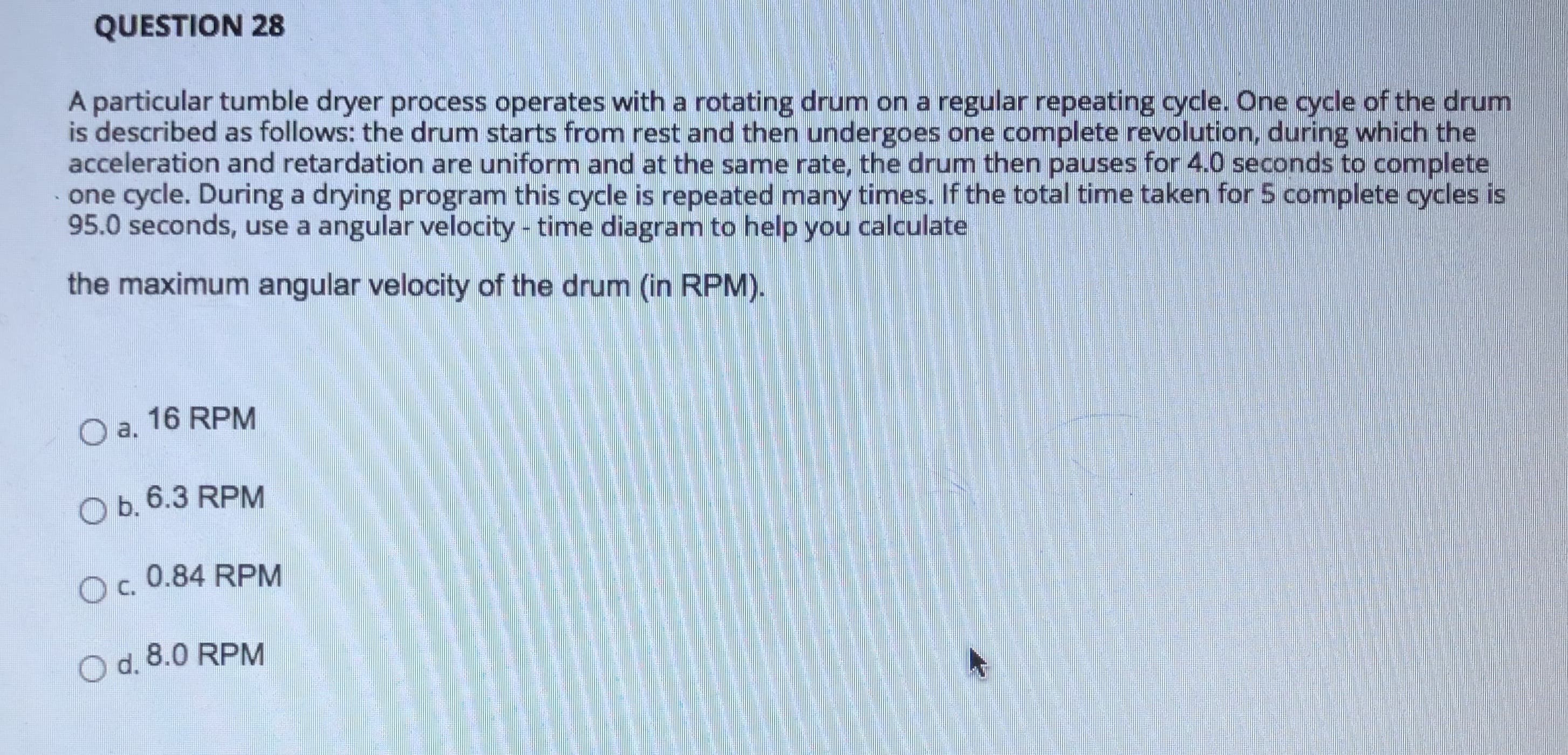A particular tumble dryer process operates with a rotating drum on a regular repeating cycle. One cycle of the drum is described as follows: the drum starts from rest and then undergoes one complete revolution, during which the acceleration and retardation are uniform and at the same rate, the drum then pauses for 4.0 seconds to complete one cycle. During a drying program this cycle is repeated many times. If the total time taken for 5 complete cycles is 95.0 seconds, use a angular velocity - time diagram to help you calculate the maximum angular velocity of the drum (in RPM).
A particular tumble dryer process operates with a rotating drum on a regular repeating cycle. One cycle of the drum is described as follows: the drum starts from rest and then undergoes one complete revolution, during which the acceleration and retardation are uniform and at the same rate, the drum then pauses for 4.0 seconds to complete one cycle. During a drying program this cycle is repeated many times. If the total time taken for 5 complete cycles is 95.0 seconds, use a angular velocity - time diagram to help you calculate the maximum angular velocity of the drum (in RPM).
Principles of Physics: A Calculus-Based Text
5th Edition
ISBN:9781133104261
Author:Raymond A. Serway, John W. Jewett
Publisher:Raymond A. Serway, John W. Jewett
Chapter10: Rotational Motion
Section: Chapter Questions
Problem 64P: Review. A mixing beater consists of three thin rods, each 10.0 cm long. The rods diverge from a...
Related questions
Question
this question follow to another question in the previous file question #26 , 27

Transcribed Image Text:A particular tumble dryer process operates with a rotating drum on a regular repeating cycle. One cycle of the drum
is described as follows: the drum starts from rest and then undergoes one complete revolution, during which the
acceleration and retardation are uniform and at the same rate, the drum then pauses for 4.0 seconds to complete
one cycle. During a drying program this cycle is repeated many times. If the total time taken for 5 complete cycles is
95.0 seconds, use a angular velocity - time diagram to help you calculate
the maximum angular velocity of the drum (in RPM).
Expert Solution
This question has been solved!
Explore an expertly crafted, step-by-step solution for a thorough understanding of key concepts.
This is a popular solution!
Trending now
This is a popular solution!
Step by step
Solved in 2 steps with 2 images

Knowledge Booster
Learn more about
Need a deep-dive on the concept behind this application? Look no further. Learn more about this topic, physics and related others by exploring similar questions and additional content below.Recommended textbooks for you

Principles of Physics: A Calculus-Based Text
Physics
ISBN:
9781133104261
Author:
Raymond A. Serway, John W. Jewett
Publisher:
Cengage Learning

Physics for Scientists and Engineers, Technology …
Physics
ISBN:
9781305116399
Author:
Raymond A. Serway, John W. Jewett
Publisher:
Cengage Learning

University Physics Volume 1
Physics
ISBN:
9781938168277
Author:
William Moebs, Samuel J. Ling, Jeff Sanny
Publisher:
OpenStax - Rice University

Principles of Physics: A Calculus-Based Text
Physics
ISBN:
9781133104261
Author:
Raymond A. Serway, John W. Jewett
Publisher:
Cengage Learning

Physics for Scientists and Engineers, Technology …
Physics
ISBN:
9781305116399
Author:
Raymond A. Serway, John W. Jewett
Publisher:
Cengage Learning

University Physics Volume 1
Physics
ISBN:
9781938168277
Author:
William Moebs, Samuel J. Ling, Jeff Sanny
Publisher:
OpenStax - Rice University

Classical Dynamics of Particles and Systems
Physics
ISBN:
9780534408961
Author:
Stephen T. Thornton, Jerry B. Marion
Publisher:
Cengage Learning